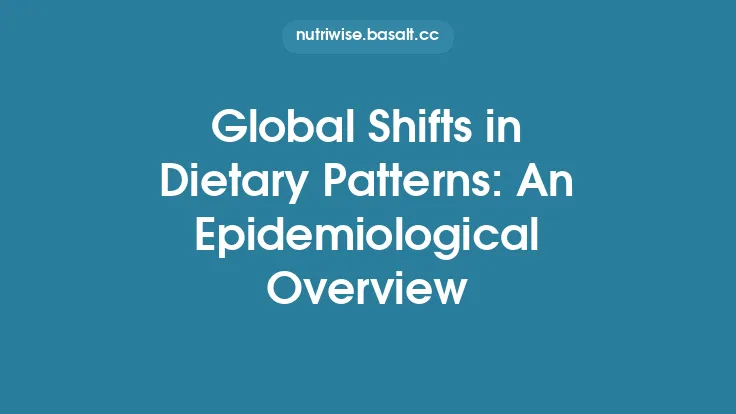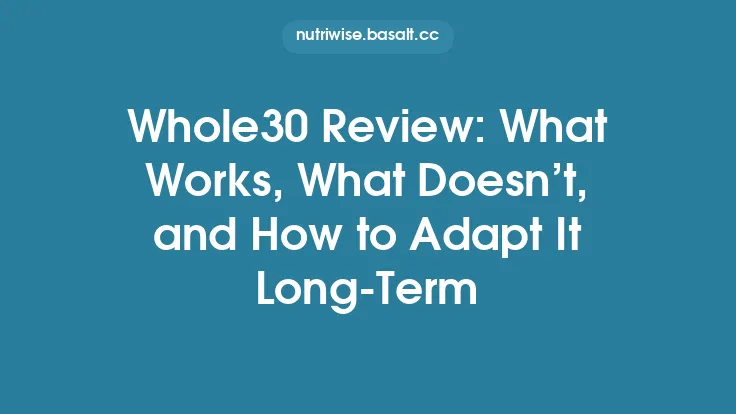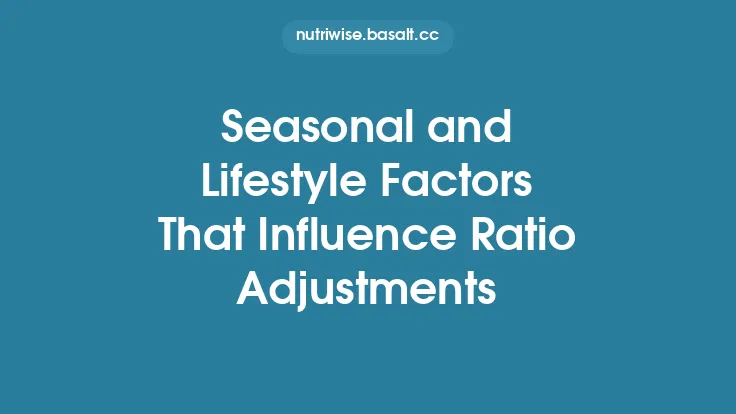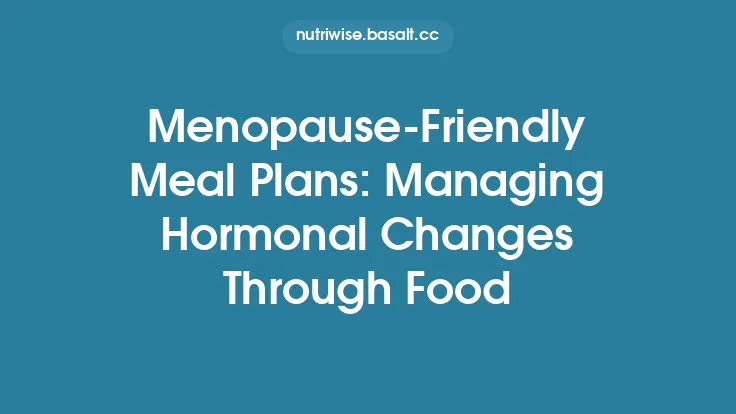Adopting a new way of eating is rarely a simple matter of swapping one food for another; it is fundamentally a transformation of the mental models that guide everyday choices. When the underlying mindset aligns with the desired dietary pattern, the behavior becomes self‑reinforcing rather than a series of will‑power battles. Below are the core mindset shifts that research and practice have shown to underpin sustainable, long‑term dietary change.
From Fixed to Growth‑Oriented Thinking
A fixed mindset treats eating habits as static traits—“I’m just not a “salad person” or “I’ll never give up sugar.” In contrast, a growth‑oriented mindset views eating behaviors as skills that can be developed through practice and learning. This shift is supported by neuroplasticity research, which demonstrates that repeated exposure to new food choices reshapes neural pathways, making healthier options feel more natural over time.
Practical steps
- Reframe setbacks: Instead of labeling a slip as “failure,” describe it as “an opportunity to identify triggers and adjust the plan.”
- Track learning moments: Keep a brief journal noting what new foods you tried, what you liked, and what you might tweak next time. Over weeks, the accumulation of these micro‑wins reinforces the belief that change is possible.
Embracing Process Over Outcome
Many diet plans hinge on end‑point metrics such as weight loss or a specific body composition. While these can be useful markers, anchoring identity to a single outcome creates a fragile motivation structure. Shifting focus to the daily process—how meals are planned, prepared, and enjoyed—creates a more resilient framework.
Why it works
- Immediate feedback: Process‑oriented actions (e.g., cooking a vegetable stir‑fry) provide tangible, daily satisfaction, reducing reliance on delayed results.
- Reduced pressure: When the goal is “eat a balanced plate each day,” the binary success/failure dichotomy dissolves, allowing for flexibility.
Implementation tip
Adopt a “plate rule” (e.g., half vegetables, quarter protein, quarter whole grains) and check it each meal. The rule becomes a habit cue rather than a distant target.
From Restriction to Abundance Mindset
Traditional dieting language often emphasizes “what you can’t have,” which triggers scarcity thinking and can lead to rebound overeating. An abundance mindset reframes the narrative to “what you can add.” This subtle linguistic shift changes the brain’s reward circuitry, encouraging exploration of nutrient‑dense foods rather than avoidance.
Actionable approach
- Create a “nutrient addition list.” Each week, add one new fruit, vegetable, legume, or whole grain to your grocery list. The focus is on inclusion, not exclusion.
- Celebrate variety: At the end of each day, note three different foods you enjoyed. Over time, the brain learns to associate eating with novelty and pleasure.
Cultivating a Long‑Term Temporal Perspective
Short‑term thinking—“I’ll eat this cake now and worry about it later”—undermines consistency. Research on temporal discounting shows that people heavily devalue future rewards when immediate gratification is available. Training the mind to value future health benefits can be achieved through mental simulation techniques.
Technique
- Future self‑visualization: Spend a few minutes each week vividly imagining yourself 5–10 years ahead, engaging in activities you value (e.g., hiking, playing with grandchildren) while feeling energetic and healthy. Linking present food choices to that future self strengthens the perceived relevance of today’s decisions.
From “All‑Or‑Nothing” to “Flexible Consistency”
Rigid dietary rules often lead to an “all‑or‑nothing” mentality, where a single deviation triggers a complete abandonment of the plan. Flexible consistency acknowledges that occasional deviations are normal, provided the overall pattern remains health‑supportive.
How to embed flexibility
- Set a “flexibility budget.” For example, allow one indulgent meal per week without guilt. The budget is pre‑planned, reducing impulsive decisions.
- Use the “90‑day rule.” Evaluate adherence over a rolling 90‑day window rather than day‑to‑day. This smooths out inevitable fluctuations and highlights the overall trend.
Aligning Eating with Core Values
When dietary choices resonate with personal values—such as environmental stewardship, animal welfare, or cultural heritage—they become an expression of identity rather than a chore. This alignment creates intrinsic reinforcement that is less susceptible to external pressures.
Steps to uncover alignment
- Identify top three values (e.g., sustainability, family health, cultural tradition).
- Map food choices to each value (e.g., plant‑based meals for sustainability, cooking family recipes for tradition).
- Create a “values‑food matrix” that you can refer to when planning meals, ensuring each plate reflects at least one core value.
Developing Adaptive Self‑Compassion
Self‑compassion involves treating oneself with the same kindness and understanding one would offer a friend. In the context of dietary change, it mitigates the harsh self‑criticism that often leads to abandonment. While self‑efficacy is a related concept, the focus here is on the emotional stance toward oneself during the change process.
Practice
- Three‑sentence self‑compassion script after a perceived slip:
- “I notice I’m feeling disappointed.”
- “It’s understandable to have setbacks; many people experience them.”
- “I will choose one small, supportive action for my next meal.”
Repeating this script rewires the brain’s stress response, lowering cortisol spikes that can otherwise trigger cravings.
Leveraging Habit Stacking for Automaticity
The habit loop—cue, routine, reward—underlies most eating behaviors. By “stacking” a new healthy habit onto an existing, well‑established routine, the brain can more readily encode the new behavior. This technique bypasses the need for constant conscious decision‑making.
Example stack
- Cue: After brushing teeth in the morning.
- New routine: Prepare a smoothie with at least one vegetable.
- Reward: Enjoy the taste and note the energy boost mid‑morning.
Over weeks, the cue automatically triggers the healthier routine, reducing reliance on willpower.
Practicing Mindful Awareness Without Over‑Analyzing
Mindfulness is often conflated with obsessive tracking of every bite, which can paradoxically increase stress. A balanced mindful approach encourages present‑moment awareness of hunger, satiety, and sensory experience without turning meals into data collection exercises.
Guidelines
- Three‑senses check: Before eating, pause to notice the color, aroma, and texture of the food.
- Hunger‑satiety scale: Rate hunger on a 1–10 scale before and after the meal; aim for a moderate post‑meal rating (4–6).
- Brief reflection: After the meal, note one aspect you enjoyed. This reinforces positive associations without detailed calorie counting.
Integrating Continuous Learning and Feedback Loops
Sustainable dietary change is a dynamic system. Treating it as a learning project—where data is collected, hypotheses are tested, and adjustments are made—creates a feedback loop that keeps the process engaging and evidence‑based.
Structure
- Set a measurable, process‑focused hypothesis (e.g., “Adding a legume to two meals per week will increase protein intake without increasing total calories.”)
- Collect simple data (e.g., weekly food log of legume servings).
- Review after four weeks and decide whether to maintain, modify, or expand the habit.
This scientific mindset reduces emotional attachment to any single plan and encourages adaptability.
Summary of Core Mindset Shifts
| Shift | Core Idea | Practical Anchor |
|---|---|---|
| Fixed → Growth | Skills can be developed | Reframe setbacks as learning |
| Outcome → Process | Focus on daily actions | Plate rule, habit tracking |
| Restriction → Abundance | Add nutrient‑dense foods | “Nutrient addition list” |
| Short‑Term → Long‑Term | Value future health | Future self visualization |
| All‑Or‑Nothing → Flexible Consistency | Allow planned deviations | Flexibility budget, 90‑day rule |
| Unaligned → Value‑Aligned | Food reflects personal values | Values‑food matrix |
| Self‑Criticism → Self‑Compassion | Kind internal dialogue | Three‑sentence script |
| Unstructured → Habit Stacking | Pair new habits with old cues | Morning brush → smoothie |
| Over‑Analysis → Balanced Mindfulness | Sensory awareness, not data obsession | Three‑senses check |
| Static → Learning Loop | Treat diet as a project | Hypothesis → data → review |
By internalizing these mindset shifts, individuals move from a reactive, rule‑bound approach to a proactive, values‑driven, and adaptable relationship with food. The result is not merely a temporary diet but a lasting, self‑sustaining pattern of eating that can weather trends, life changes, and inevitable fluctuations in motivation.





